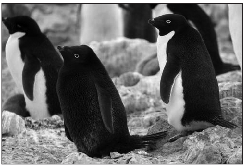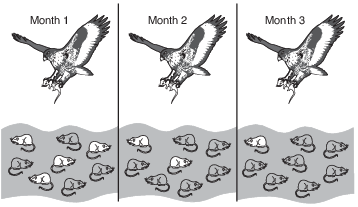Topic: Traits And Natural Selection
Traits And Natural Selection
In order to determine the effect of a certain antibiotic on a species of microorganism, an investigation was carried out. A sample of a specific species of microorganism was added to 100 mL of a liquid culture medium. One mL of a solution of the antibiotic was then added to that culture medium. Each day at 10 a.m., 1 mL of the experimental culture medium was removed and the number of microorganisms in the 1-mL sample was determined. The 1 mL of experimental culture medium was replaced by 1 mL of new sterile culture medium to maintain a constant volume. The results are shown in the table below.

Directions: Using the information in the data table, construct a line graph on the grid, following the directions below.
The microorganisms present on day 5 were
(1) newly added from the sterile culture medium
(2) offspring of antibiotic-resistant individuals
(3) organisms that were all present on day 1
(4) offspring with no resistance to the antibiotic
The graph below shows the changes in the num- ber of individuals in a population who have a specific trait.

Which statement concerning this trait is a valid inference?
(1) As time passed, an increasing number of individuals with this trait survived and reproduced.
(2) Individuals can acquire new survival characteristics over time and pass them on to their offspring.
(3) The longer a species is in an environment, the less likely it is that mutations will occur within the species.
(4) The number of traits a species possesses has a direct relationship to the amount of time the species will exist.
The photograph below shows a recently discovered all-black penguin chick and several typical black- and-white chicks.

The appearance of this penguin chick with all black feathers might
(1) increase the types of foods penguins can eat
(2) decrease the diversity of the penguin population
(3) decrease the number of variations present in the black penguin population
(4) result in an increase in black penguins over time if the trait provides a reproductive advantage
During certain times of the year, bears feed heavily on a population of fish in a lake. At other times of the year, the bear population feeds primarily on fruits, berries, and insects.

Within the fish population, variations exist in color, size, gamete production, and swimming speed. A variation that would most likely be passed on to future generations of the species is
(1) a swimming speed that is less than that of its predators
(2) the presence of bright, colorful markings that contrast with the lake bottom
(3) being of a size that enables them to hide among the rocks in the lake
(4) the production of a small number of gametes during the peak of the breeding season

How does the ability to produce 3000 to 6500 eggs benefit the species?
(1) It decreases the opportunity for more frogs to compete for limited resources.
(2) More offspring are likely to survive and reproduce.
(3) The offspring will be more widely distributed by fast-moving water.
(4) The chances for asexual reproduction in the frogs will increase.
Parrots are tropical birds. However, in some areas of New York City, some parrots have been able to survive outdoors year-round. These parrots survive, while most others cannot, due to
(1) overproduction of offspring
(2) extinction of previous species
(3) asexual reproduction of parrots with a mutation
(4) a variation that allows these parrots to live in colder climates
Characteristics that are harmful to a species tend to decrease in frequency from generation to generation because these characteristics usually
(1) have a high survival value for the species
(2) have a low survival value for the species
(3) are inherited by more individuals
(4) affect only the older members of the population
The diagram below represents the same field of mice hunted by a hawk over a period of three months.

The overall changes in the population of mice can be explained best by
(1) natural selection
(2) succession
(3) reproduction
(4) mouse extinction
Identify one trait, other than a beak characteristic, that could affect the survival of a finch. Support your answer. [1]
Allow 1 credit for identifyng one trait, other than beak characteristic, that could affect the survival
• of a finch and supporting the answer. Acceptable responses include, but are not limited to:
• Coloration:
• — Camouflage would help survival.
• — attract a mate for successful reproduction
• Strength:
• — helps in competition for food
• Aggressiveness:
• — helps in competition for mate/food
Other than having a variation in beak characteristics, describe another variation in a finch species that could promote survival of an individual bird. Support your answer. [1]
Allow 1 credit for describing another variation in a finch species that could promote survival of an
• individual bird and supporting the answer. Acceptable responses include, but are not limited to:
• — Some birds may fly better, helping them escape predators better.
• — Some finches might have colors that help them hide from predators.
• — Some of them might be smaller and need less food for survival.
• — Some birds are more aggressive, so they get more food.
Rising CO2 [Carbon Dioxide] Levels in Ocean Block Sharks’ Ability to Smell Prey
…Changes in the chemistry of the world’s oceans expected by century’s end could impact the hunting ability of sharks, which depend heavily on their sense of smell to locate prey, researchers say.
As ocean waters turn increasingly acidic from absorbing atmospheric CO2 created by human activities, the odor-detecting ability of sharks to locate prey could diminish, they say. …
Source: Jim Algar, Tech Times, 9/9/14
Describe how the inability of sharks to detect their prey could affect an ocean ecosystem. [1]
Allow 1 credit. Acceptable responses include, but are not limited to:
• — The sharks might not detect enough prey to feed on and might not survive.
• — Since sharks lack the ability to detect their food source, the population of their prey would
• sharply increase.
• — There could be an increase in prey and a decrease in the populations which the prey
• consume.
• — Without the shark population holding its prey in check, the number of prey will increase.
In many areas, there are some small mammals whose fur color is influenced by temperature. In these animals, the trait for fur color is expressed only if the air temperature is above a certain level. In cold weather, when the ground is covered with snow, the trait is not expressed and the fur color is white.
Explain how the fur color change trait may help the small mammals survive. [1]
Allow 1 credit. Acceptable responses include, but are not limited to:
• — The trait increases chances for survival of the small mammals by helping them blend into
• their environment.
• — They can avoid being eaten by predators if they are camouflaged.
New varieties of organisms have resulted from human activities. These organisms have often led to problems in modern society. Two of these new varieties are listed below.
Antibiotic-resistant bacteria Pesticide-resistant insects
Select one of these varieties and discuss a problem associated with the development of this new variety of organism. In your answer, be sure to:
• identify the variety you selected
• identify one biological process by which a population of this variety may develop resistance [1]
• describe how this process is involved in the production of a population of resistant organisms [1]
• identify one problem caused by this resistance [1]
• state one solution to this problem [1]
• identify one possible negative effect of this solution [1]
Variety: ________________________________
The student’s response to the bulleted items in the question need not appear in the following order.
• 13 Allow 1 credit for identifying one biological process by which a population of this variety may develop resistance. Acceptable responses include, but are not limited to:
• — natural selection
• — evolution
• — reproduction
• — mutation
• 14 Allow 1 credit for describing how this process is involved in the production of a population of resistant organisms. Acceptable responses include, but are not limited to:
• Natural Selection:
• — The population had some members that were naturally resistant to antibiotics. They survived and reproduced, passing on the resistance.
• Evolution:
• — Some organisms were resistant to the pesticide. They survived and passed on the trait.
• Reproduction:
• — Resistant members survived and passed on the trait.
• Mutation:
• — It produces variations that give some organisms a survival advantage.
• Note: Allow credit for a response consistent with the process identified in question 13 .
• 16 Allow 1 credit for identifying one problem caused by this resistance. Acceptable responses include, but are not limited to:
• — Resistant bacteria will survive and continue to make people sick.
• — Insects will continue to destroy crops.
• — Antibiotics do not work anymore.
• — There will be less food available.
• 17 Allow 1 credit for stating one solution to this problem. Acceptable responses include, but are not
• limited to:
• — Do not use antibiotics/antibacterial products unless needed.
• — Use different antibiotics or pesticides.
• — Use a natural predator for pests.
• — Insert genes into plants that will make them resistant to bacteria or pests.
• — Research and find new antibiotics/ways of controlling insect pests.
• Note: Allow credit for a response consistent with the problem identified in question 16 .
• 19 Allow 1 credit for identifying one possible negative effect of this solution. Acceptable responses include, but are not limited to:
• — People might be sick longer.
• — More people could get sick.
• — Organisms may become resistant to other treatments.
• — Natural predators may get out of control.
• — Inserted genes may have an undesired effect.
• — Research takes a lot of time and money.
• Note: Allow credit for a response consistent with the student’s solution to question 17 .
Inherited instructions control the color patterns of snakes. Some snakes that are not poisonous have colors that resemble the patterns on poisonous snakes. Predators avoid eating harmless snakes that have color patterns similar to those of the poisonous snakes. The results of a recent study indicate that predators in areas that have only harmless snakes do not avoid attacking snakes that have color patterns similar to poisonous snakes.
State one advantage for a nonpoisonous snake having coloration similar to that of a poisonous snake. [1]
Allow 1 credit. Acceptable responses include, but are not limited to:
• — Predators will avoid it.
• — Predators might mistake it for a poisonous snake and not eat it.
A woman wanted to remove the dandelion plants from her lawn. She went to the store and bought an herbicide spray that was supposed to kill the dandelions. She sprayed it on her lawn according to the directions. Within two weeks, almost all of the dandelions had died; however, a few dandelions remained.
Explain how some dandelions were able to survive the spraying of the herbicide. [1]
Allow 1 credit. Acceptable responses include, but are not limited to:
• — Some plants had a gene that made them resistant to the herbicide.
• — Some plants were resistant.
• — Some did not get enough spray to kill them.
• — Some had a mutation that caused them to be resistant.
